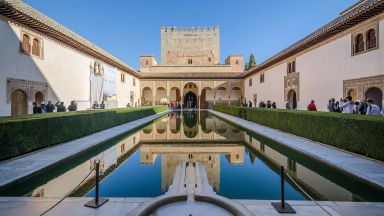Sala del Mexuar
Palace in Granada
The Sala del Mexuar or Hall of the Mexuar is part of the Palacio del Mexuar, one of the palaces that make up the Palacio Nazaríes in the Alhambra Complex, in Granada, Spain.
The Palacio de El Mexuar is the oldest of the three palaces that make up the Palacio Nazaríes and this is evident in this room as it has suffered the most from the transformations that have occurred over the centuries as it adapted it to new services and functions. There was also an explosion of a powder magazine in 1590, which damaged part of the Palace.
What does the Sala del Mexuar look like?
Four columns stand in the middle of the hall, with corbels of mocarabes. The following text appears on the plaster frieze: “Everything that you own comes from God“.
The ceiling, from the Christian period, is a coffered ceiling with interlacing decoration.
The wall, on its higher part is decorated with plaster work, golden elements and paintings.
The the lower wall of the dado features repeating Islamic tile, probably date from the sixteenth century, and the work of a Sevillian potter, Juan Pulido. Hidden within them are the coat of arms of the Nasarid Sultans, Count Of Tendilla, the double headed eagle of the Holy Romans Emperor and the twin columns of Hercules.




The tile showing the Pillars of Hercules, an ancient name given to the Strait of Gibraltar. This was the personal motto of the Monarch Plus Ultra, means ‘further beyond’ in Latin and was the battle cry of the conquistadors, as they strove “ever further” to claim lands for the Spanish Empire.


The twin plaques of Carlos V stands out with its Christian motto painted on the tiles of the wall. Plūs Ultré, The motto is wrapped around the columns of Hercules and has a border of Moorish bows from the 16th century.
History of the Sala del Mexuar
The Sala del Mexuar during the Nasrid Period
The Mexuar was built around 1320, in the time of Sultan Ismail the First (1314-1325). Ismail I, would have listened to his advisers and administered justice from here. It was adapted by Yusuf I (1333-1354). According to Ibn al-Khatib, Muhammad V (1362-1391), Ismail I’s grandson who made further changes this room after regaining power on March 16, 1362 and inaugurated his new Mexuar on the feast day of Mawlid (the birth of the Prophet) in 1362. During the lifetime of Muhammad V, in 1370, the grand project of the building of the Comares Palace, started by his father was finished. He moved his audience chamber eastward to the Patio del Cuarto Dorado.
During this time you would have entered the chamber from the Patio de Machuca.
At that time, the hall was covered by an impressive polychrome glass roof, supported by the four marble columns, that you can still see. It had an elevated chamber closed by lattices where the sultan sat to listen without being seen. Side windows did not exist. Some of the roof trusses are still the original ones, recognizable for keeping traces of their darker polychromy.
The Sala del Mexuar during the period of Charles V
For his arrival of Charles V the Sala del Mexuar had been converted into a chapel. The room had been extended to the north, and a second floor built, to house the choir, only the balustrade of which can still be seen, spanning the room. In the south the Emperors coat of arms was added to the wall with tiles, with a crown in stone above. The easternmost set of tiles was moved to the east wall when the doorway was added in 1935. Between to two set of tiles would have been the altar. The exit that takes you to the Cuarto Dorado had been filled in during this period. The door was ‘found’ and recovered in 1947, and the tiles that covered it moved to the museum.
Where does the Sala del Mexuar get its name?
It owes its name to the Arabic term Maswar, where the Sura or Council of Ministers met.
The Sala del Mexuar appears in our Complete Guide to Visiting Granada!
Other names of Sala del Mexuar
The Sala del Mexuar has the following names: Sala del Mexuar, Hall of the Mexuar.
This website uses affiliate links which may earn a commission at no additional cost to you!
Visiting Sala del Mexuar
Nearby Attractions
- Palacio del Mexuar (0.0) km
Palace in Granada - Patio del Cuarto Dorado (0.0) km
Courtyard in Granada - Facade of the Palace of Comares (0.0) km
Palace in Granada - Cuarto Dorado (0.0) km
Palace in Granada - Oratorio de Mexuar (0.0) km
Historic Room in Granada - Patio de Machuca (0.0) km
Fountain and Gardens in Granada - Torre de Machuca (0.0) km
Tower in Granada - Palacio Nazaríes (0.0) km
Palace in Granada - Sala de la Barca (0.0) km
Historic Room in Granada - Palacio de Comares (0.0) km
Palace in Granada



